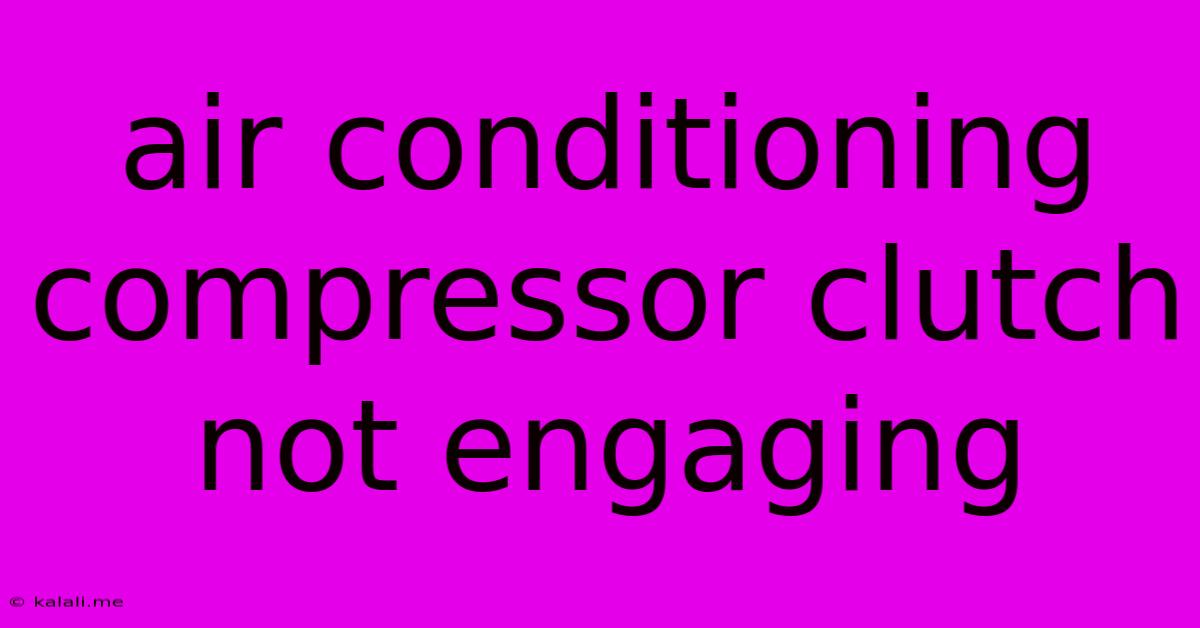Air Conditioning Compressor Clutch Not Engaging
Kalali
Jun 05, 2025 · 4 min read

Table of Contents
Air Conditioning Compressor Clutch Not Engaging: Troubleshooting and Repair
Your car's air conditioning is essential, especially during those sweltering summer months. When the compressor clutch isn't engaging, you're left with a hot and uncomfortable ride. This article will guide you through troubleshooting why your AC compressor clutch isn't engaging, potential causes, and some DIY repair options. Understanding the issue can save you money on expensive repair bills.
What is the AC Compressor Clutch?
The AC compressor clutch is an electromagnetic device that connects and disconnects the compressor from the engine's drive belt. When the clutch engages, the compressor circulates refrigerant, cooling your car's interior. A malfunctioning clutch prevents this crucial process, resulting in a non-functioning AC system.
Symptoms of a Non-Engaging AC Compressor Clutch:
- No cold air: This is the most obvious symptom. Your air conditioning system simply won't blow cold air.
- Compressor doesn't cycle on: You might hear the engine running, but the compressor itself remains silent.
- Clicking sound: A faint clicking sound near the compressor may indicate the clutch is trying to engage but failing.
- AC system pressure issues: Low refrigerant levels can also prevent the clutch from engaging. This is often related to leaks in the AC system.
Common Causes of a Non-Engaging AC Compressor Clutch:
Several factors can prevent your AC compressor clutch from engaging. Here are some of the most frequent culprits:
1. Low Refrigerant:
A low refrigerant level is a common cause. The system's pressure switches are designed to prevent the compressor from running if the refrigerant level is too low to protect it from damage. Check your refrigerant level – a significant drop indicates a leak that needs professional attention. Improper charging of refrigerant can also lead to this problem.
2. Faulty Clutch Relay:
The clutch relay acts as a switch, activating the clutch when the AC is turned on. A faulty relay prevents power from reaching the clutch. Testing the relay with a multimeter is a relatively simple diagnostic step.
3. Bad Clutch Coil:
The clutch coil is an electromagnet responsible for engaging the clutch. If the coil is damaged or burnt out, it won't generate the necessary magnetic field to engage the clutch. Testing the coil's resistance with a multimeter can confirm its condition.
4. Worn-out Clutch Plate:
Over time, the clutch plate can wear down, preventing proper engagement. The plate may be worn, warped, or damaged. Visual inspection of the clutch plate is necessary to assess its condition. This often requires removing the compressor clutch itself.
5. Wiring Issues:
Damaged or loose wiring between the AC control system, the relay, and the clutch coil can disrupt the electrical circuit, preventing the clutch from engaging. Inspect the wiring for breaks, fraying, or corrosion.
6. Problems with the AC Pressure Switch:
The pressure switch monitors the refrigerant pressure. If the pressure is too low or high, the switch prevents the compressor from activating. This often occurs in conjunction with low refrigerant, but a faulty pressure switch is possible.
7. Faulty Compressor:
In some cases, the compressor itself might be faulty, preventing the clutch from engaging, even if all other components are functioning correctly. This is a less common cause, but it should be considered if other issues have been ruled out.
Troubleshooting Steps:
- Check the refrigerant level: This is the first step. Low refrigerant is a major cause.
- Inspect the wiring: Look for any signs of damage, loose connections, or corrosion.
- Test the clutch relay: Use a multimeter to verify its functionality.
- Test the clutch coil: Use a multimeter to check the coil's resistance.
- Visually inspect the clutch plate: Check for wear, damage, or warping.
DIY Repair vs. Professional Help:
While some repairs, such as replacing the relay or checking the wiring, are manageable DIY projects, more complex repairs like replacing the clutch coil or compressor typically require professional expertise and specialized tools.
Conclusion:
A non-engaging AC compressor clutch can be frustrating, but by systematically troubleshooting the potential causes, you can identify the problem and take steps to fix it. Remember to prioritize safety and seek professional help if you're not comfortable performing complex repairs. Early diagnosis and proper maintenance can keep your air conditioning running cool all summer long.
Latest Posts
Latest Posts
-
Mac Fix Or Merge Mp4 Files
Jun 07, 2025
-
R Change A Matrix Columns And Rows
Jun 07, 2025
-
Non Inverting Vs Inverting Op Amp
Jun 07, 2025
-
Fallout 4 Dogmeat Sanctuary Hills Location
Jun 07, 2025
-
Baptism Of The Holy Spirit Verses
Jun 07, 2025
Related Post
Thank you for visiting our website which covers about Air Conditioning Compressor Clutch Not Engaging . We hope the information provided has been useful to you. Feel free to contact us if you have any questions or need further assistance. See you next time and don't miss to bookmark.